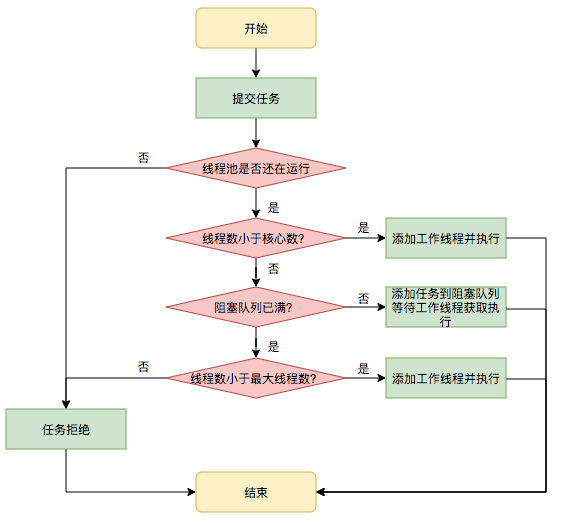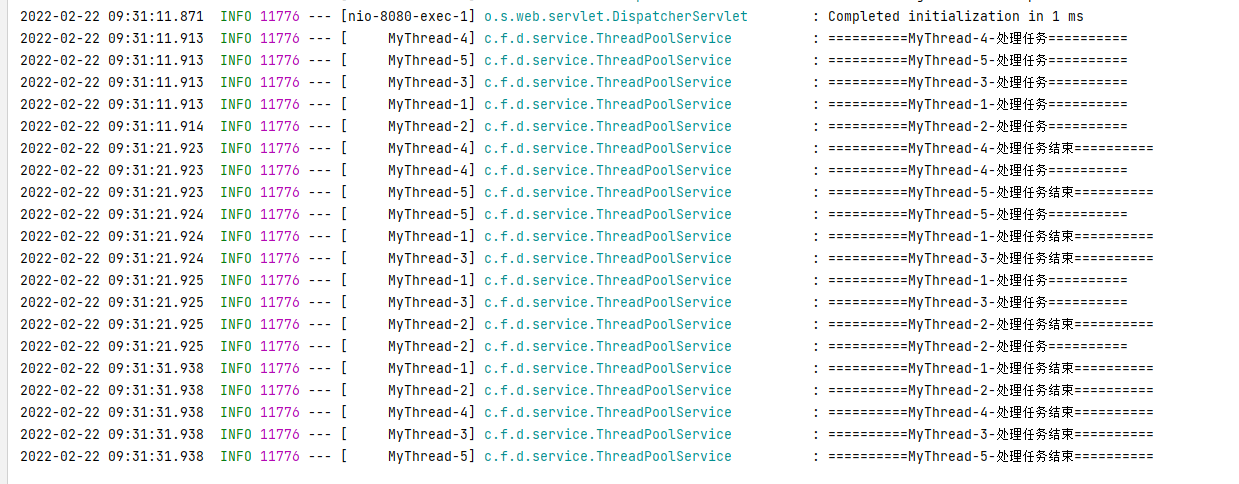首页
点滴
SpringBoot 中使用JDK提供的线程池ThreadPoolExecutor
#### JDK提供的线程池ThreadPoolExecutor的构造方法如下 ```java public ThreadPoolExecutor(int corePoolSize, int maximumPoolSize, long keepAliveTime, TimeUnit unit, BlockingQueue<Runnable> workQueue, ThreadFactory threadFactory, RejectedExecutionHandler handler) ``` ``` corePoolSize:核心线程线,池中保留的线程数。如果设置了allowCoreThreadTimeOut=true,线程空闲时会销毁 maximumPoolSize:池中允许的最大线程数; keepAliveTime:当线程数大于核心数时,多余线程的存活时间; unit:keepAliveTime参数的时间单位; workQueue:用于存放已提交至线程池但未被执行的任务 threadFactory:用于创建线程的工厂,开发者可以通过自定义ThreadFactory来创建线程,比如,根据业务名为线程命名、设置线程优先级、设置线程是否为守护线程等、设置线程所属的线程组等; handler:拒绝策略,当阻塞队列已满并且已到达最大线程数,这个时候线程池就会拒绝新增的任务,该参数主要用于设置拒绝策略 ``` #### 四种拒绝策略 `ThreadPoolExecutor.AbortPolicy`默认拒绝策略,即丢弃任务并抛出RejectedExecutionException异常 `ThreadPoolExecutor.DiscardPolicy`丢弃任务,但是不抛出异常 `ThreadPoolExecutor.DiscardOldestPolicy`丢弃队列最前面的任务,然后提交被当前任务 `ThreadPoolExecutor.CallerRunsPolicy`由调用者线程处理当前任务 #### 任务执行机制 1、首先检测线程池运行状态,如果不是Running,则直接拒绝;线程池要保证在Running的状态下执行任务。 2、如果workerCount < corePoolSize,则创建并启动一个线程来执行新提交的任务。 3、如果workerCount >= corePoolSize,且线程池内的阻塞队列未满,则将任务添加到该阻塞队列中。 4、如果workerCount >= corePoolSize && workerCount < maximumPoolSize,且线程池内的阻塞队列已满,则创建并启动一个线程来执行新提交的任务。执行完新提交的任务后,再去执行任务队列里面的任务,把任务队列里的任务全都执行完之后,空闲下来的时间到达设置的空闲存活时间就被销毁 5、如果workerCount >= maximumPoolSize,并且线程池内的阻塞队列已满, 则根据拒绝策略来处理该任务, 默认的处理方式是直接抛异常。  #### 在SpringBoot如何使用 1、新建`threadpool.properties`线程池配置文件,各参数如下 ``` thread-pool.config.corePoolSize = 5 thread-pool.config.maxPoolSize = 20 thread-pool.config.queueCapacity = 20 thread-pool.config.threadNamePrefix = MyThread- thread-pool.config.rejectedExecutionHandler = CallerRunsPolicy ``` 2、新建`ThreadPoolConfig.java `线程池配置类 ```java @EnableAsync @Configuration @PropertySource("classpath:threadpool.properties") // 指定配置文件 public class ThreadPoolConfig { @Value("${thread-pool.config.corePoolSize:10}") private Integer corePoolSize; // 核心线程数 @Value("${thread-pool.config.maxPoolSize:20}") private Integer maxPoolSize; // 最大线程数 @Value("${thread-pool.config.keepAliveTime:60}") private Integer keepAliveTime; // 空闲线程的等待时间 @Value("${thread-pool.config.queueCapacity:50}") private Integer queueCapacity; // 等待队列的长度 @Value("${thread-pool.config.threadNamePrefix:MyThread-}") private String threadNamePrefix; // 线程名前缀 @Value("${thread-pool.config.rejectedExecutionHandler:CallerRunsPolicy}") private String rejectedExecutionHandler; // 拒绝策略 @Bean(name = "myThreadPool") public Executor myThreadPool() { // 自定义线程工厂 ThreadFactory threadFactory = new ThreadFactory() { private int i = 1; @Override public Thread newThread(Runnable r) { Thread thread = new Thread(r); thread.setName(threadNamePrefix + i); i++; return thread; } }; // 初始化线程池 ThreadPoolExecutor threadPoolExecutor = new ThreadPoolExecutor(corePoolSize, maxPoolSize, keepAliveTime, TimeUnit.SECONDS, new LinkedBlockingQueue<>(queueCapacity), threadFactory, getRejectedExecutionHandler(rejectedExecutionHandler)); return threadPoolExecutor; } /** * 根据传入的参数获取拒绝策略 * @param rejectedName 拒绝策略名,比如 CallerRunsPolicy * @return RejectedExecutionHandler 实例对象,没有匹配的策略时,默认取 CallerRunsPolicy 实例 */ public RejectedExecutionHandler getRejectedExecutionHandler(String rejectedName){ Map<String, RejectedExecutionHandler> rejectedExecutionHandlerMap = new HashMap<>(16); rejectedExecutionHandlerMap.put("CallerRunsPolicy", new ThreadPoolExecutor.CallerRunsPolicy()); rejectedExecutionHandlerMap.put("AbortPolicy", new ThreadPoolExecutor.AbortPolicy()); rejectedExecutionHandlerMap.put("DiscardPolicy", new ThreadPoolExecutor.DiscardPolicy()); rejectedExecutionHandlerMap.put("DiscardOldestPolicy", new ThreadPoolExecutor.DiscardOldestPolicy()); return rejectedExecutionHandlerMap.getOrDefault(rejectedName, new ThreadPoolExecutor.CallerRunsPolicy()); } } ``` 3、新建测试Controller以及Service类 ThreadPoolController.java ```java @RestController @RequestMapping("/threadPool") public class ThreadPoolController { @Autowired ThreadPoolService threadPoolService; @RequestMapping("/test") public void test(){ // 循环调用10次 for (int i = 0; i < 10; i++) { threadPoolService.threadPoolTest(); } } } ``` ThreadPoolService.java ```java @Service public class ThreadPoolService { private static final Logger log = LoggerFactory.getLogger(ThreadPoolService.class); @Async("myThreadPool") // 指定前面ThreadPoolConfig配置类中配置的线程池Bean名 public void threadPoolTest() { log.info("=========="+Thread.currentThread().getName()+"-处理任务=========="); try { Thread.sleep(10*1000); // 睡眠10秒,模拟处理业务逻辑耗费时间 log.info("=========="+Thread.currentThread().getName()+"-处理任务结束=========="); } catch (InterruptedException e) { e.printStackTrace(); } } } ``` 4、查看测试结果打印输出,因为只配了5个核心线程数,同时调用了10次异步方法,所以只有5个线程在同时工作,其他5个任务会放到阻塞队列中等待,直到5个工作线程中有结束的线程,该空闲线程才从等待队列中拿出待执行的任务开始执行。 
博客分类
源码解析 (1)
多线程 (5)
Java (10)
Linux (8)
Docker (9)
SpringBoot (14)
微服务 (1)
Redis (15)
MySQL (7)
VMware (3)
Nginx (15)
MyBatis (2)
RabbitMQ (1)
Git (7)
工具类 (12)
前端 (3)
友情链接
layui
© 2020-2025 www.chenhuazhan.com All Rights Reserved 备案号:
桂ICP备17004487号-1
粤公网安备44030002005146